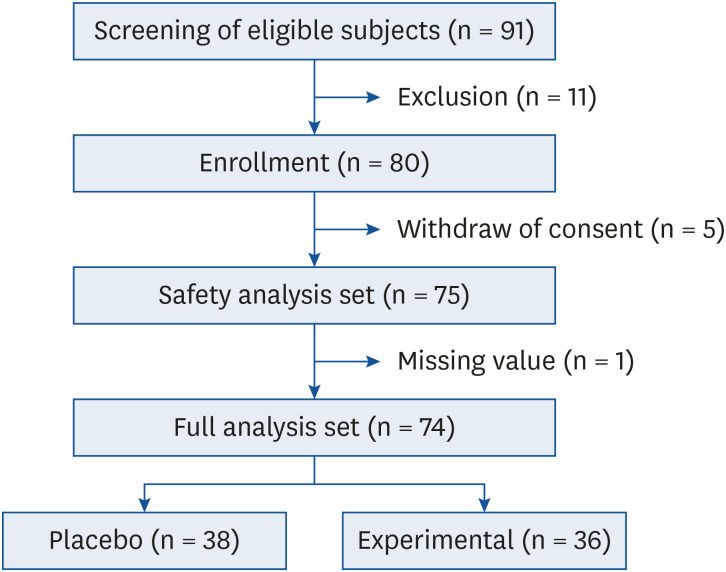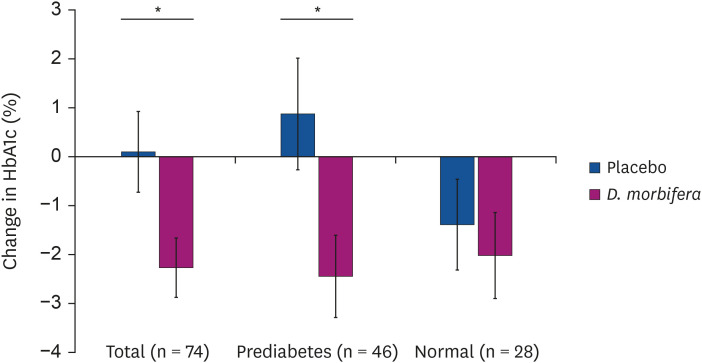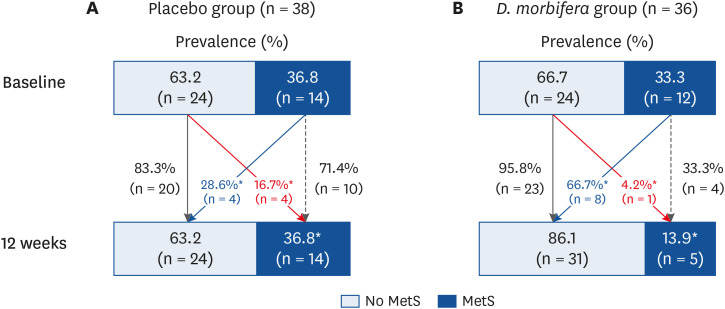Nutr Res Pract.
2022 Feb;16(1):60-73. 10.4162/nrp.2022.16.1.60.
The efficacy and safety of Dendropanax morbifera leaf extract on the metabolic syndrome: a 12-week, placebo controlled, double blind, and randomized controlled trial
- Affiliations
-
- 1Department of Endocrinology and Metabolism, Kyung Hee University Hospital at Gangdong, Kyung Hee University School of Medicine, Seoul 05278, Korea
- 2Department of Preventive Pharmacy and Toxicology, Department of Life and Nanopharmaceutical Sciences of Pharmacy, College of Pharmacy, Kyung Hee University, Seoul 02447, Korea
- KMID: 2525513
- DOI: http://doi.org/10.4162/nrp.2022.16.1.60
Abstract
- BACKGROUND/OBJECTIVES
The extract from Dendropanax morbifera exhibited diverse therapeutic potentials. We aimed to evaluate the efficacy and safety of D. morbifera leaf extract for improving metabolic parameters in human.
SUBJECTS/METHODS
A 12-week, double blind, placebo-controlled and randomized trial included a total of 74 adults, and they were assigned to the placebo group (n = 38) or 700 mg/day of D. morbifera group (n = 36). The efficacy endpoints were changes in glycemic, lipid, obesity, and blood pressure (BP) parameters, in addition to the prevalence of metabolic syndrome (MetS) and the numbers of MetS components. Safety was assessed by monitoring adverse events (AEs).
RESULTS
After 12 weeks of treatment, the hemoglobin A1c (HbA1c) level significantly decreased in the D. morbifera group compared to that of the placebo group (difference: −0.13 ± 0.20% vs. 0.00 ± 0.28%, P = 0.031; % of change: −2.27 ± 3.63% vs. 0.10 ± 5.10%, P = 0.025). The homeostatic model assessment for insulin resistance level also decreased significantly from its baseline in the D. morbifera group. The systolic BP of D. morbifera group decreased significantly than that of placebo group (difference: −3.9 ± 9.8 mmHg vs. 3.3 ± 11.7 mmHg, P = 0.005; % of change: −2.8 ± 7.7% vs. 3.3 ± 10.2%, P = 0.005). However, the lipid parameters and body composition including body weight did not differ between the groups. The prevalence of MetS (36.8% vs. 13.9%, P = 0.022) and the incidence of MetS (10.5% vs. 13.9%, P = 0.027) at 12 weeks was significantly lower in the D. morbifera group than it was in the placebo group. No serious AEs occurred in either group.
CONCLUSIONS
Supplementation with D. morbifera extracts over a 12-week period improved metabolic parameters such as HbA1c and BP and reduced the prevalence of MetS.
Keyword
Figure
Reference
-
1. Mayans L. Metabolic syndrome: insulin resistance and prediabetes. FP Essent. 2015; 435:11–16. PMID: 26280340.2. Huh JH, Ahn SG, Kim YI, Go T, Sung KC, Choi JH, Koh KK, Kim JY. Impact of longitudinal changes in metabolic syndrome status over 2 years on 10-year incident diabetes mellitus. Diabetes Metab J. 2019; 43:530–538. PMID: 30877706.
Article3. Graf BL, Raskin I, Cefalu WT, Ribnicky DM. Plant-derived therapeutics for the treatment of metabolic syndrome. Curr Opin Investig Drugs. 2010; 11:1107–1115.4. Marles RJ, Farnsworth NR. Antidiabetic plants and their active constituents. Phytomedicine. 1995; 2:137–189. PMID: 23196156.
Article5. Sultana S, Asif HM. Review: Medicinal plants combating against hypertension: a green antihypertensive approach. Pak J Pharm Sci. 2017; 30:2311–2319. PMID: 29175804.6. Cabral CE, Klein MR. Phytosterols in the treatment of hypercholesterolemia and prevention of cardiovascular diseases. Arq Bras Cardiol. 2017; 109:475–482. PMID: 29267628.
Article7. Park BY, Min BS, Oh SR, Kim JH, Kim TJ, Kim DH, Bae KH, Lee HK. Isolation and anticomplement activity of compounds from Dendropanax morbifera . J Ethnopharmacol. 2004; 90:403–408. PMID: 15013208.8. Bae K, editor. The Medicinal Plants of Korea. Seoul: Kyo-Hak Publishing;2000.9. Hyun TK, Ko YJ, Kim EH, Chung IM, Kim JS. Anti-inflammatory activity and phenolic composition of Dendropanax morbifera leaf extracts. Ind Crops Prod. 2015; 74:263–270.10. Moon HI. Antidiabetic effects of dendropanoxide from leaves of Dendropanax morbifera Leveille in normal and streptozotocin-induced diabetic rats. Hum Exp Toxicol. 2011; 30:870–875. PMID: 20716587.11. Kang MJ, Kwon EB, Ryu HW, Lee S, Lee JW, Kim DY, Lee MK, Oh SR, Lee HS, Lee SU, et al. Polyacetylene from Dendropanax morbifera alleviates diet-induced obesity and hepatic steatosis by activating AMPK signaling pathway. Front Pharmacol. 2018; 9:537. PMID: 29875667.
Article12. Chung IM, Kim MY, Park WH, Moon HI. Antiatherogenic activity of Dendropanax morbifera essential oil in rats. Pharmazie. 2009; 64:547–549. PMID: 19746846.13. Jo YB, Lee JH. A study on the effect of the Dendropanax mobifera extract on anti-hypertensive. J Korea Acad Ind Coop Soc. 2016; 17:708–715.14. Yang HY, Kim KS, Lee YH, Park JH, Kim JH, Lee SY, Kim YM, Kim IS, Kacew S, Lee BM, et al. Dendropanax morbifera ameliorates thioacetamide-induced hepatic fibrosis via TGF-β1/Smads pathways. Int J Biol Sci. 2019; 15:800–811. PMID: 30906211.15. Birhanu BT, Kim JY, Hossain MA, Choi JW, Lee SP, Park SC. An in vivo immunomodulatory and anti-inflammatory study of fermented Dendropanax morbifera Léveille leaf extract. BMC Complement Altern Med. 2018; 18:222. PMID: 30041643.
Article16. Akram M, Kim KA, Kim ES, Syed AS, Kim CY, Lee JS, Bae ON. Potent anti-inflammatory and analgesic actions of the chloroform extract of Dendropanax morbifera mediated by the Nrf2/HO-1 pathway. Biol Pharm Bull. 2016; 39:728–736. PMID: 27150144.17. American Diabetes Association. 2. Classification and diagnosis of diabetes: Standards of Medical Care in Diabetes—2019. Diabetes Care. 2019; 42:S13–28. PMID: 30559228.18. An NY, Kim JE, Hwang D, Ryu HK. Anti-diabetic effects of aqueous and ethanol extract of Dendropanax morbifera Leveille in streptozotocin-induced diabetes model. J Nutr Health. 2014; 47:394–402.19. Tan X, Ryu HK. Effects of Dendropanax morbifera leaf extracts on lipid profiles in mice fed a high-fat and high-cholesterol diet. J Korean Soc Food Sci Nutr. 2015; 44:641–648.20. Song JH, Kang HB, Kim JH, Kwak S, Sung GJ, Park SH, Jeong JH, Kim H, Lee J, Jun W, et al. Antiobesity and cholesterol-lowering effects of Dendropanax morbifera water extracts in mouse 3T3-L1 cells. J Med Food. 2018; 21:793–800. PMID: 30048215.21. Youn JS, Kim MS, Na HJ, Jung HR, Song CK, Kang SY, Kim JY. Screening test for Dendropanax morbifera Leveille extracts: in vitro comparison to ox-LDL-induced lipid accumulation, ethanol-induced fatty liver and HMG-CoA reductase inhibition. J Appl Biol Chem. 2018; 61:1–8.22. Soleimani M. Insulin resistance and hypertension: new insights. Kidney Int. 2015; 87:497–499. PMID: 25723632.
Article23. Saad MF, Rewers M, Selby J, Howard G, Jinagouda S, Fahmi S, Zaccaro D, Bergman RN, Savage PJ, Haffner SM. Insulin resistance and hypertension: the Insulin Resistance Atherosclerosis study. Hypertension. 2004; 43:1324–1331. PMID: 15123571.24. Esposito K, Giugliano D. The metabolic syndrome and inflammation: association or causation? Nutr Metab Cardiovasc Dis. 2004; 14:228–232. PMID: 15673055.
Article25. Choo GS, Lim DP, Kim SM, Yoo ES, Kim SH, Kim CH, Woo JS, Kim HJ, Jung JY. Anti-inflammatory effects of Dendropanax morbifera in lipopolysaccharide-stimulated RAW264.7 macrophages and in an animal model of atopic dermatitis. Mol Med Rep. 2019; 19:2087–2096. PMID: 30747232.
- Full Text Links
- Actions
-
Cited
- CITED
-
- Close
- Share
- Similar articles
-
- Antimicrobial, Antioxidant and Cytotoxic Activities of Dendropanax morbifera Léveille extract for mouthwash and denture cleaning solution
- Effects of Korean Red Ginseng on Cardiovascular Risks in Subjects with Metabolic Syndrome: a Double-blind Randomized Controlled Study
- First Report of Foliar Blight on Dendropanax morbifera Caused by Alternaria panax
- Double-blind, Parallel-group, Placebo-controlled Multi-center Clinical Trial for Evaluating the Efficacy and Safety of Phentermine Hydrochloride in Obese Patients
- The Effect of Pomegranate on Postmenopausal Syndrome: A Randomized, Double-blind, Placebo-controlled Trial




